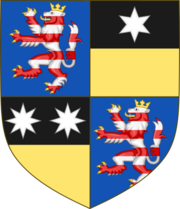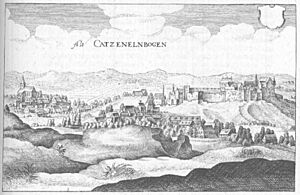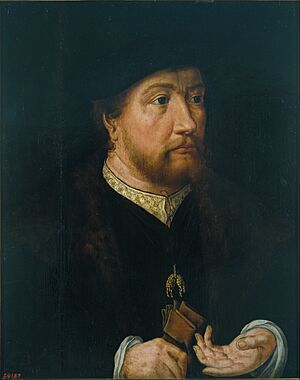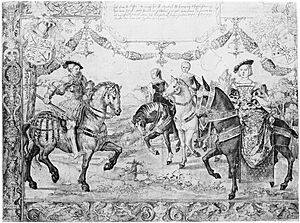Elisabeth of Hesse-Marburg facts for kids
Quick facts for kids
Elisabeth of Hesse-Marburg
|
|
|---|---|
| Countess Consort of Nassau-Siegen | |
| Coat of arms |  |
| Full name |
Elisabeth Landgravine of Hesse-Marburg
|
| Native name | Elisabeth Landgräfin von Hessen-Marburg |
| Born | May 1466 Marburg |
| Died | 17 January 1523 Cologne |
| Buried | St. John's Church, Franciscan monastery, Siegen Reburied: St. Mary's Church, Siegen 1836 |
| Noble family | House of Hesse-Marburg |
| Spouse(s) | John V, Count of Nassau-Siegen |
| Issue Detail |
|
| Father | Henry III the Rich of Hesse-Marburg |
| Mother | Anne of Katzenelnbogen |
Elisabeth of Hesse-Marburg (born May 1466 – died 17 January 1523) was a noblewoman from the House of Hesse. She was a Landgravine, which is like a countess who rules a special territory called a Landgraviate. When she married John V, Count of Nassau-Siegen, she became the Countess of Nassau-Siegen.
Elisabeth was also the main heir to a rich area called the County of Katzenelnbogen. After her brother passed away, both she and the Landgraviate of Hesse claimed this land. This led to a long legal fight between Elisabeth's family (the House of Nassau) and the House of Hesse. This dispute, known as the Katzenelnbogische Erbfolgestreit, continued even after Elisabeth's death.
Contents
Early Life and Family
Elisabeth was born in Marburg in May 1466. She was the oldest daughter of Henry III the Rich of Hesse-Marburg, who was a Landgrave, and Countess Anne of Katzenelnbogen.
Elisabeth's mother, Anne, was the daughter of Count Philip the Elder of Katzenelnbogen. Philip the Elder had two sons, but both died young without children. When Philip the Elder died in 1479, his daughter Anne and her husband Henry III (Elisabeth's parents) inherited the County of Katzenelnbogen.
Elisabeth married Count John V of Nassau-Siegen in Marburg on 11 February 1482. John was born in Breda on 9 November 1455 and died in Dillenburg or Siegen on 30 July 1516.
The Fight for Katzenelnbogen

Elisabeth's father died in 1483. His son, William III the Younger, took over. William said his sisters, Elisabeth and Matilda, should get 50,000 florins (a type of money). John, Elisabeth's husband, disagreed in 1488. He felt his wife should get more from her family's inheritance.
In 1500, William III the Younger died without any children. His land, the Landgraviate of Hesse-Marburg, went to William II the Middle of Hesse-Kassel. Matilda gave up her claim to the inheritance, making Elisabeth the only heir to Katzenelnbogen. Elisabeth claimed all her brother's lands, and John immediately called himself the Count of Katzenelnbogen.
The County of Katzenelnbogen was very important. It was located between the Taunus mountains and the Lahn river. It was also very rich because it collected many tolls (fees) from ships on the Rhine River. This made it a very desirable land for both the House of Hesse and the House of Nassau.
In 1501, Holy Roman Emperor Maximilian I told William II the Middle not to take Katzenelnbogen by force. John also received some parts of Katzenelnbogen from other rulers. However, William II the Middle took control of Katzenelnbogen anyway, ignoring Elisabeth's rights. John tried to talk things out, but it didn't work. He didn't want to fight the powerful House of Hesse, so he took his case to the Reichskammergericht (an important court). In 1507, the court decided that Elisabeth should get half of the county. But William II the Middle refused to accept this decision.
After John died in 1516, Elisabeth's sons, Henry and William, continued the fight with even more energy. Henry was very important and close to Roman King Charles V. This gave the Nassau family strong support in their long legal battle. On the other side was the strong young Landgrave Philip I the Magnanimous of Hesse. He had an advantage because Hesse already controlled the disputed land.
In 1520, Charles V moved the case to another court, the Reichshofrat. This was good for Elisabeth because Henry's secretary worked as a judge there. The case was even discussed at the Diet of Worms in 1521, a big meeting of leaders. But still, no final decision was made.
A group of important bishops was asked to re-examine the case. They made their decision in Tübingen on 9 May 1523. The decision was good for Elisabeth, giving her almost the entire inheritance.
Elisabeth died in Cologne on 17 January 1523, shortly before the verdict. She was buried next to her husband in a church in Siegen. In 1836, they were both reburied in another church in Siegen.
The dispute was not fully settled until 1557, because Philip of Hesse still refused to give Katzenelnbogen to Elisabeth's son, William.
The Nassau Tapestries: A Mystery?
Around 1531, Elisabeth's son, Henry III, ordered a series of eight tapestries. These tapestries showed the family tree of the House of Nassau. The original tapestries are now lost, but seven of the design drawings made by Bernard van Orley still exist.
Each tapestry showed a man and a woman riding horses, facing each other. The last drawing in the series is special because it shows three women instead of one. The words on this drawing say it shows John V and Elisabeth of Hesse-Marburg. However, the man in the drawing wears the special collar of the Order of the Golden Fleece. John V was never a member of this order, but his son Henry III was.
This has led to a lot of discussion. Some experts believe the words on the drawing are wrong. They think the drawing actually shows Henry III and his three wives. This is because the man looks like Henry III in other portraits, he wears the Golden Fleece collar, and there are three women (Henry had three wives). Also, one of the women rides a mule, which was common for women in Spain, and Henry's third wife, Mencía de Mendoza, was Spanish.

Other experts argue that the words on the drawing are correct. They say that Henry III might have looked like his father, John V. They also point out that the series was meant to show ancestors, not the person who ordered the tapestries (Henry III). The extra women might represent other important family members related to the Katzenelnbogen inheritance, like Elisabeth's sister Matilda or John V's sister Anne. These women were important to the family's claim to the land.
The debate continues, but the drawing remains a fascinating part of the Nassau family history.
Elisabeth's Children
Elisabeth and John had the following children:
- Count Henry III (born 12 January 1483 – died 14 September 1538). He became a count after his uncle Engelbert II died in 1504. Henry married three times:
- on 3 August 1503 to Countess Françoise Louise of Savoy-Vaud;
- on 24 April 1515 to Claudia of Chalon;
- on 30 June 1524 to Mencía de Mendoza y Fonseca.
- John (born 3 November 1484 – died 15 August 1504?).
- Ernest (born 9 April 1486 – died 12 October 1486).
- Count William I the Rich (born 10 April 1487 – died 6 October 1559). He became a count after his father died in 1516. William married twice:
- on 29 May 1506 to Countess Walburga of Egmont;
- on 20 September 1531 to Countess Juliane of Stolberg-Wernigerode.
- Elisabeth (born 1488 – died 3 June 1559). She married Count John III of Wied in February 1506.
- Mary (born February 1491 – died 1547). She married Count Jobst I of Holstein-Schauenburg-Pinneberg in February 1506.
Elisabeth and Mary had a big double wedding celebration in Siegen in February 1506. There was a feast at the city hall, and the city council even gave 16 oxen and 19 pigs for the meal! The celebrations were very grand, with lots of expensive fabrics bought for the dresses and decorations.



